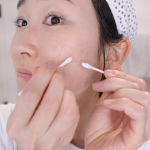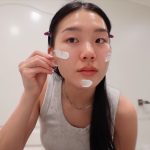One of the primary causes is a yeast-like fungus called Malassezia, which occurs naturally on the scalp but can overgrow and lead to irritation and flaking. Other factors contributing to dandruff include dry skin, sensitivity to hair products, and not shampooing enough, which can result in a buildup of oil and dead skin cells. These factors create an environment conducive to dandruff development.
Effective scalp care involves addressing the root causes of dandruff. Using anti-dandruff shampoos containing active ingredients like zinc pyrithione, coal tar, or ketoconazole can help reduce fungus and control flaking. Regularly washing hair with a gentle shampoo and ensuring thorough rinsing can prevent oil and product buildup. Additionally, maintaining scalp hydration with moisturizing treatments and avoiding excessive use of hair products can promote a healthier scalp environment, reducing the likelihood of dandruff recurrence.
What Causes Dandruff?
Understanding the underlying causes of dandruff involves exploring various factors that contribute to its occurrence on the scalp. Dandruff is primarily triggered by the overgrowth of a naturally occurring yeast-like fungus called Malassezia. This fungus feeds on the scalp’s natural oils, breaking them down into substances that can irritate the skin, leading to flaking. Other contributing factors include dry scalp conditions, sensitivity to certain hair products, and irregular shampooing habits that allow for the buildup of dead skin cells and oils. Environmental factors such as cold weather and stress can also exacerbate dandruff symptoms. By addressing these causes through proper scalp hygiene, the use of appropriate anti-dandruff products, and managing environmental and lifestyle factors, individuals can effectively mitigate and prevent dandruff outbreaks, promoting a healthier scalp environment.
Understanding the underlying causes of dandruff involves exploring various factors that contribute to its occurrence on the scalp. Identifying these factors is crucial for effective management and prevention of dandruff.
- Role of Malassezia Fungus in Dandruff Formation. Dandruff is primarily triggered by the overgrowth of Malassezia, a yeast-like fungus that thrives on the scalp’s natural oils. This fungus breaks down oils into substances that can irritate the scalp, leading to flaking and itching. Managing the population of Malassezia through the use of anti-dandruff shampoos containing ingredients like zinc pyrithione or ketoconazole can help control its growth and reduce dandruff symptoms effectively.
- Impact of Scalp Conditions and Hair Products. Dry scalp conditions and sensitivity to certain hair products can exacerbate dandruff symptoms. Individuals prone to dry scalp should prioritize moisturizing shampoos and conditioners to maintain scalp hydration. Choosing hair products labeled as non-comedogenic and avoiding those containing harsh chemicals can also prevent scalp irritation and reduce flaking. Regular shampooing with mild, pH-balanced products helps remove dead skin cells and oils, preventing buildup that can contribute to dandruff.
- Environmental and Lifestyle Factors. Environmental factors such as cold weather and humidity levels can influence dandruff severity. Cold weather can lead to dry scalp, while humidity can exacerbate fungal growth. Managing these environmental factors by wearing protective headgear in cold weather and maintaining a consistent scalp care routine can help minimize dandruff outbreaks. Additionally, stress is known to weaken the immune system and increase susceptibility to skin conditions like dandruff. Practicing stress-reduction techniques, such as mindfulness and exercise, can contribute to scalp health and reduce dandruff flare-ups.
- Effective Management Strategies. Addressing the underlying causes of dandruff through proper scalp hygiene and the use of appropriate anti-dandruff products is essential for effective management. Regular scalp cleansing with gentle, moisturizing shampoos helps maintain scalp health and reduces flaking. Using anti-dandruff shampoos as directed by dermatologists and incorporating scalp treatments like scalp massages or exfoliation can further enhance scalp condition. Consulting dermatologists for personalized advice and treatment plans ensures that individuals receive tailored care for persistent dandruff cases, promoting long-term scalp health and reducing the recurrence of symptoms.
Where Does Dandruff Occur on the Scalp?
Dandruff typically manifests on specific areas of the scalp where conditions are conducive to its development. The most common areas affected are the scalp’s oily regions, such as around the hairline, behind the ears, and the crown of the head. These areas tend to have higher concentrations of sebaceous glands, which produce oils that Malassezia fungi thrive on. Moreover, dandruff can extend to the entire scalp, depending on the severity of the condition and individual scalp characteristics. Understanding the distribution of dandruff helps in targeting treatment more effectively, focusing on cleansing and treating these specific areas to alleviate symptoms and maintain scalp health.
Understanding the distribution of dandruff on the scalp provides insights into effective treatment strategies. Dandruff tends to concentrate in specific oily regions where conditions favor fungal growth and flaking.
- Areas Around the Hairline. Dandruff commonly appears around the hairline due to the presence of sebaceous glands that produce oils, creating an ideal environment for Malassezia fungi. Treating this area involves gentle cleansing and targeted anti-dandruff products to alleviate symptoms and maintain scalp health.
- Behind the Ears. The skin behind the ears, another oily area, is prone to dandruff due to its proximity to sebaceous glands. Managing dandruff in this area requires thorough cleansing and regular application of suitable treatments to prevent flaking and irritation.
- Crown of the Head. Dandruff often affects the crown of the head where sebaceous glands are more concentrated. Effective treatment involves using anti-dandruff shampoos and scalp treatments to control fungal activity and reduce flaking.
- Scalp Extent. Depending on severity, dandruff can extend across the entire scalp. Managing widespread dandruff involves consistent scalp hygiene and the use of medicated shampoos to maintain a healthy scalp environment and minimize flaking.
When Does Dandruff Typically Flare Up?
Dandruff flare-ups typically occur under specific conditions that exacerbate scalp irritation and fungal activity. These flare-ups are often more pronounced during colder months when indoor heating systems reduce humidity, leading to drier scalp conditions that exacerbate flaking. Additionally, periods of high stress can trigger or worsen dandruff due to hormonal changes that affect oil production and immune function. For some individuals, hormonal fluctuations during puberty, pregnancy, or menopause can also increase susceptibility to dandruff outbreaks. Understanding these triggers helps in managing dandruff effectively by adjusting skincare routines, minimizing stress levels, and using appropriate anti-dandruff products to maintain scalp health and reduce flaking.
Understanding the causes of dandruff involves recognizing several contributing factors.
- Scalp Microorganisms and Skin Conditions. Dandruff can arise from an imbalance of scalp microorganisms, notably Malassezia fungi, which metabolize scalp oils and produce irritating byproducts. Additionally, skin conditions like seborrheic dermatitis or psoriasis can lead to dandruff due to accelerated skin shedding and inflammation.
- Sebum Production and Hygiene. Excessive sebum production can contribute to dandruff by providing a fertile environment for Malassezia growth. Poor scalp hygiene, including infrequent washing or inadequate rinsing of hair products, may also lead to dandruff-causing buildup of oils and skin cells.
- Environmental and Lifestyle Factors. Environmental factors such as cold weather or dry indoor heating can exacerbate scalp dryness, triggering dandruff. Stress, hormonal fluctuations, and dietary imbalances are also linked to dandruff onset, highlighting the multifaceted nature of its causes. Understanding these factors is crucial for implementing effective scalp care strategies to manage and prevent dandruff.
Who is Most Prone to Dandruff?
Individuals most prone to dandruff often have certain predisposing factors that contribute to its development on the scalp. Those with oily skin types tend to be more susceptible as excess sebum provides an ideal environment for Malassezia fungi, which contribute to dandruff formation. People with compromised immune systems or chronic illnesses may also experience dandruff more frequently due to reduced ability to fight off fungal infections. Additionally, stress and hormonal fluctuations can play a significant role, exacerbating dandruff symptoms. Understanding these risk factors helps tailor treatment approaches, such as using anti-dandruff shampoos or adjusting diet and lifestyle to manage and reduce dandruff occurrences effectively.
Understanding the predisposing factors for dandruff helps identify those at higher risk and tailor effective treatment strategies. Factors such as skin type, immune system health, stress levels, and hormonal changes significantly influence dandruff susceptibility.
- Oily Skin Types. Individuals with oily skin types are more prone to dandruff because excess sebum provides a nourishing environment for Malassezia fungi, which contribute to flaking and scalp irritation. Using clarifying shampoos and scalp treatments can help manage oil production and reduce dandruff symptoms effectively.
- Compromised Immune Systems. People with compromised immune systems or chronic illnesses may experience more frequent dandruff outbreaks due to a reduced ability to combat fungal infections. Managing underlying health conditions and incorporating scalp hygiene practices are essential in controlling dandruff and promoting scalp health.
- Stress Levels. High levels of stress can exacerbate dandruff symptoms by influencing oil production and immune responses. Practicing stress-reduction techniques such as meditation, yoga, or regular exercise can help mitigate these effects and reduce the frequency of dandruff flare-ups.
- Hormonal Fluctuations. Hormonal changes, such as those occurring during puberty, pregnancy, or menopause, can increase susceptibility to dandruff. Adjusting skincare routines, using gentle anti-dandruff products, and maintaining a balanced diet can help manage hormonal influences on scalp health and reduce dandruff occurrences.
How to Effectively Treat and Prevent Dandruff?
Effectively treating and preventing dandruff involves adopting a comprehensive approach that addresses both the underlying causes and symptoms of this common scalp condition. Using anti-dandruff shampoos containing active ingredients like zinc pyrithione, salicylic acid, or ketoconazole can help control fungal growth and reduce flaking. Regular scalp cleansing with gentle, moisturizing shampoos helps remove excess oil and dead skin cells, preventing buildup that can contribute to dandruff. Additionally, maintaining a balanced diet rich in vitamins and minerals supports scalp health, while managing stress levels and avoiding harsh hair treatments further aids in prevention. Tailoring skincare routines to individual needs and seeking dermatological advice for persistent cases ensures effective management and long-term relief from dandruff symptoms.
- Choosing the Right Anti-Dandruff Shampoo. Using anti-dandruff shampoos containing active ingredients like zinc pyrithione, salicylic acid, or ketoconazole can effectively control fungal growth and reduce flaking. These ingredients work to combat the Malassezia fungus, which is often responsible for causing dandruff. Regular use of these shampoos helps maintain a healthy scalp environment, minimizing dandruff recurrence and promoting overall scalp health.
- Implementing Proper Scalp Cleansing Techniques. Regular scalp cleansing with gentle, moisturizing shampoos is essential for removing excess oil and dead skin cells that can contribute to dandruff. Gentle massage during shampooing helps improve blood circulation to the scalp, promoting a healthier environment for hair growth and reducing the likelihood of dandruff. This cleansing routine should be complemented with occasional exfoliation using a scalp scrub to further remove buildup and maintain scalp hygiene.
- Supporting Scalp Health Through Diet and Lifestyle. Maintaining a balanced diet rich in vitamins and minerals supports overall scalp health and helps prevent dandruff. Foods rich in B vitamins, zinc, and essential fatty acids contribute to a healthy scalp environment. Additionally, managing stress levels through relaxation techniques and regular exercise can reduce flare-ups of dandruff, as stress is known to exacerbate scalp conditions. Avoiding harsh hair treatments and minimizing exposure to environmental pollutants also play a crucial role in maintaining scalp health and preventing dandruff.
- Seeking Professional Advice for Persistent Cases. Tailoring skincare routines to individual needs and seeking dermatological advice for persistent dandruff cases ensures effective management and long-term relief. Dermatologists can prescribe specialized treatments, such as medicated shampoos or topical treatments, tailored to the specific needs of the scalp. They can also conduct assessments to identify underlying causes, such as fungal infections or skin conditions, which may require targeted therapies for effective resolution of dandruff symptoms. Regular follow-ups and adjustments to the treatment plan ensure ongoing management and prevention of dandruff.
Conclusion: Effective Strategies for Managing Dandruff
Addressing dandruff effectively requires targeting its root causes, notably the overgrowth of Malassezia fungus and factors like dry scalp and product sensitivity. Using anti-dandruff shampoos with ingredients such as zinc pyrithione or ketoconazole helps control fungal growth and reduces flaking. Regularly washing hair with gentle shampoos and ensuring thorough rinsing prevents oil buildup. Maintaining scalp hydration through moisturizing treatments and limiting hair product use creates a healthier scalp environment, minimizing dandruff recurrence. By understanding and managing these factors, individuals can effectively alleviate and prevent dandruff, promoting scalp health and reducing symptoms over time.








